All Exams >
MCAT >
Physics for MCAT >
All Questions
All questions of Thin Lenses for MCAT Exam
Which of the following statements accurately describes an image formed by a thin converging lens?- a)The image is always real and inverted within the focal length of the lens.
- b)The image is always larger than the object within the radius of curvature of the lens.
- c)The image is always smaller than the object outside the focal length of the lens.
- d)The image is always virtual and upright outside the radius of curvature of the lens.
Correct answer is option 'B'. Can you explain this answer?
Which of the following statements accurately describes an image formed by a thin converging lens?
a)
The image is always real and inverted within the focal length of the lens.
b)
The image is always larger than the object within the radius of curvature of the lens.
c)
The image is always smaller than the object outside the focal length of the lens.
d)
The image is always virtual and upright outside the radius of curvature of the lens.

|
Orion Classes answered |
- For a converging lens, the image is real, inverted, and reduced when the object is positioned at greater than twice the focal length or radius of curvature (O > 2F), real, inverted, and enlarged when the object is between the radius of curvature and the focal length (2F > O > F), and virtual, upright, and enlarged when the object is positioned within the focal length (O < F).
- The image is always real and inverted not within but outside the focal length of the lens.
- The image is always virtual and upright not outside the radius of curvature but within the focal point of the lens.
- The image is always smaller than the object outside not the focal length but the radius of curvature of the lens.
- Correctly stated, the image is always larger than the object within the radius of curvature of the lens.
One of the challenges of using an astronomical telescope for terrestrial use is the production of an inverted image. Which of the following changes to the astronomical telescope would invert the image for terrestrial use?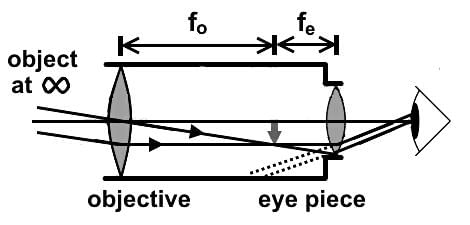
- a)Move the eyepiece to within the focal point of the objective such that their focal lengths overlap
- b)Change the eyepiece to a diverging lens leaving the lens in the same position
- c)Add a third converging lens in between such that the image from the objective falls 2 focal lengths from the lens
- d)Change the objective to a diverging lens and leave it is the same position
Correct answer is option 'C'. Can you explain this answer?
One of the challenges of using an astronomical telescope for terrestrial use is the production of an inverted image. Which of the following changes to the astronomical telescope would invert the image for terrestrial use?

a)
Move the eyepiece to within the focal point of the objective such that their focal lengths overlap
b)
Change the eyepiece to a diverging lens leaving the lens in the same position
c)
Add a third converging lens in between such that the image from the objective falls 2 focal lengths from the lens
d)
Change the objective to a diverging lens and leave it is the same position

|
Orion Classes answered |
- Changing the objective to a diverging lens would not properly gather light into the telescope in producing a virtual image outside the telescope. Only a converging lens would work for the first lens.
- Changing the eyepiece to a converging lens would not invert the image vertically but laterally. The virtual image would be projected back into the telescope rather than on the retina.
- Moving the eyepiece to within the focal point of the objective such that they overlap would require the additional step of changing the eyepiece to a diverging lens to create the virtual, upright, and enlarged image:

- Adding a third converging lens in between such that the image from the objective falls 2 focal lengths from the lens would properly invert the image:
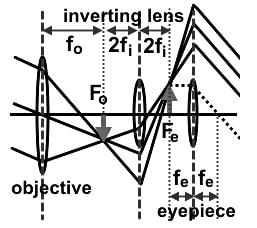
Which of the following statements best describes the schematic of the astronomical telescope below?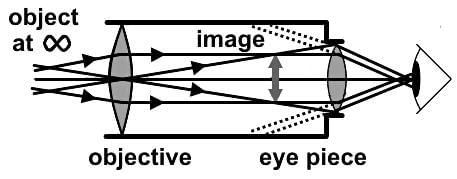
- a)Magnification can be increased by shortening the focal length of the objective.
- b)The telescope makes use of two positive lens, and each lens inverts the image such that the final image is upright.
- c)The eyepiece acts like a simple magnifier for the image produced by the objective by producing a virtual, inverted, and enlarged image at infinity.
- d)If the focal length of objective is 50 cm and the eyepiece is -10 cm, then the telescope should be at least 60 cm in length.
Correct answer is option 'C'. Can you explain this answer?
Which of the following statements best describes the schematic of the astronomical telescope below?

a)
Magnification can be increased by shortening the focal length of the objective.
b)
The telescope makes use of two positive lens, and each lens inverts the image such that the final image is upright.
c)
The eyepiece acts like a simple magnifier for the image produced by the objective by producing a virtual, inverted, and enlarged image at infinity.
d)
If the focal length of objective is 50 cm and the eyepiece is -10 cm, then the telescope should be at least 60 cm in length.

|
Orion Classes answered |
- The telescope is equal to the sum of the focal lengths of the objective and eyepiece. The focal length should have positive values they are both converging.
- Since the objective lens is responsible for gathering light.
- The telescope makes use of two converging lenses. The objective produces a real and inverted image. If you follow the light rays, they switch sides when refracting through the lens.
- The eyepiece acts like a simple magnifier to enlarge the image formed by the objective. That image should fall on or within the focal point of the eyepiece.
- Since the image from the objective is already inverted, the image produced by the eyepiece will be virtual, enlarged, and inverted.
Two lenses that are 30 centimeters apart are used to form an image. Lens 1 has a focal length f1 = -5.0 cm, and lens 2 has a focal length f2 = 15 cm. The object is placed 20 centimeters to the left of Lens 1. Which of the following statements best describes the image formed?- a)The image formed by Lens 2 is real, inverted, and reduced.
- b)The image formed by Lens 2 is real, upright, and enlarged.
- c)The image formed by Lens 1 is virtual, inverted, and reduced.
- d)The image formed by Lens 1 is virtual, upright, and enlarged.
Correct answer is option 'A'. Can you explain this answer?
Two lenses that are 30 centimeters apart are used to form an image. Lens 1 has a focal length f1 = -5.0 cm, and lens 2 has a focal length f2 = 15 cm. The object is placed 20 centimeters to the left of Lens 1. Which of the following statements best describes the image formed?
a)
The image formed by Lens 2 is real, inverted, and reduced.
b)
The image formed by Lens 2 is real, upright, and enlarged.
c)
The image formed by Lens 1 is virtual, inverted, and reduced.
d)
The image formed by Lens 1 is virtual, upright, and enlarged.
|
|
Ayesha Joshi answered |
- This problem can be solved with some ray diagrams with some deduction or with the thin lens equation performed twice.
- The first lens is diverging lens since the focal length is negative, and the second lens is converging since the focal length is positive.
- The object is placed well outside the focal length for the diverging lens, but regardless of position, the image produced is virtual, upright, and reduced. The further away from the focal length, the smaller the image.
- This virtual image is the object for the converging lens, which falls well outside the radius of curvature or twice the focal length. In this case, the second lens will produce a real, inverted, and reduced image.
Which of the following statements accurately describes the sign conventions used for the thin lens equation?- a)The focal length of a lens whose refractive power is positive is negative.
- b)While the magnitude of the magnification indicates whether an image is enlarged or reduced, the signage indicates whether it is inverted or upright.
- c)Distances to the right of the lens are negative and on the left are positive.
- d)The distance of a virtual image is positive since it appears on the same side of the lens.
Correct answer is option 'B'. Can you explain this answer?
Which of the following statements accurately describes the sign conventions used for the thin lens equation?
a)
The focal length of a lens whose refractive power is positive is negative.
b)
While the magnitude of the magnification indicates whether an image is enlarged or reduced, the signage indicates whether it is inverted or upright.
c)
Distances to the right of the lens are negative and on the left are positive.
d)
The distance of a virtual image is positive since it appears on the same side of the lens.
|
|
Owen Jenkins answered |
Explanation:
Magnification and Image Orientation:
- The sign conventions used in the thin lens equation indicate the orientation of the image formed by a lens.
- While the magnitude of the magnification tells us whether the image is enlarged or reduced, the signage (positive or negative) indicates whether the image is upright or inverted.
Positive and Negative Signs for Distances:
- In the thin lens equation, distances are measured from the lens to the object or image.
- Distances to the left of the lens are typically taken as positive, while distances to the right of the lens are considered negative.
Virtual Images and Sign Conventions:
- When an image is virtual (formed on the same side as the object), the distance is considered positive.
- Virtual images have a negative magnification value, indicating that they are upright.
Therefore, statement B accurately describes the sign conventions used for the thin lens equation as it highlights the significance of both magnitude and signage in determining the orientation of the image formed by a lens.
Magnification and Image Orientation:
- The sign conventions used in the thin lens equation indicate the orientation of the image formed by a lens.
- While the magnitude of the magnification tells us whether the image is enlarged or reduced, the signage (positive or negative) indicates whether the image is upright or inverted.
Positive and Negative Signs for Distances:
- In the thin lens equation, distances are measured from the lens to the object or image.
- Distances to the left of the lens are typically taken as positive, while distances to the right of the lens are considered negative.
Virtual Images and Sign Conventions:
- When an image is virtual (formed on the same side as the object), the distance is considered positive.
- Virtual images have a negative magnification value, indicating that they are upright.
Therefore, statement B accurately describes the sign conventions used for the thin lens equation as it highlights the significance of both magnitude and signage in determining the orientation of the image formed by a lens.
When an object is placed 45 centimeters in front of a diverging lens with a focal length of 15 centimeters, what are the image distance and the magnification?- a)d = 22.25 cm and m = -1.0
- b)d = -11.25 cm and m = 0.25
- c)d = -22.25 cm and m = 0.25
- d)d = 10.25 cm and m = 4.1
Correct answer is option 'B'. Can you explain this answer?
When an object is placed 45 centimeters in front of a diverging lens with a focal length of 15 centimeters, what are the image distance and the magnification?
a)
d = 22.25 cm and m = -1.0
b)
d = -11.25 cm and m = 0.25
c)
d = -22.25 cm and m = 0.25
d)
d = 10.25 cm and m = 4.1
|
|
Ayesha Joshi answered |
- This is a straightforward application of the thin lens formula although you could get a rough estimate from drawing a ray diagram:

- The values from the question stem are f = -15 cm and o = 45 cm. The focal length for diverging lens are negative. Object length is positive moving left starting from the lens.
- Plug in your values:

- Magnification is calculated from the image and object distances:

- The image is 11.25 cm to the left of the lens with a reduced size of 0.25.
Which of the following statements does NOT accurately describe the schematic of the compound microscope below?
- a)The image from the objective lens is produced within the focal point of the eyepiece, which then produces a real, upright, and enlarged image on the retina.
- b)The final image produced by the microscope is similar to the image produced by the astronomical telescope, which is a virtual, inverted, and enlarged image.
- c)The objective has a short focal length to produce an image that is roughly the same size and orientation as the object.
- d)By decreasing the focal length and increasing the diameter of the objective, the magnifying and light-gathering power can be increased respectively.
Correct answer is option 'A'. Can you explain this answer?
Which of the following statements does NOT accurately describe the schematic of the compound microscope below?

a)
The image from the objective lens is produced within the focal point of the eyepiece, which then produces a real, upright, and enlarged image on the retina.
b)
The final image produced by the microscope is similar to the image produced by the astronomical telescope, which is a virtual, inverted, and enlarged image.
c)
The objective has a short focal length to produce an image that is roughly the same size and orientation as the object.
d)
By decreasing the focal length and increasing the diameter of the objective, the magnifying and light-gathering power can be increased respectively.
|
|
Ayesha Joshi answered |
- The compound microscope uses an objective lens that has a short focal length, and the object sits outside the focal length of the objective.
- The objective is close to the object being viewed which focuses a real and inverted image of the object inside the microscope. The objective has a short focal length to produce an image that is roughly the same size and orientation as the object.
- The eyepiece then acts a simple magnifier since the image from the objective falls within the focal length of the eyepiece. When the object falls within the focal length, the eyepiece gives an virtual, upright, and enlarged image of the object.
- However, the image is already inverted, so here the final image is virtual, inverted, and enlarged. So the microscope produces an image similar to the telescope, which is also a virtual, inverted, and enlarged image.
- By decreasing the focal length of the objective and increasing the diameter of the objective for a microscope will increase the magnifying and light-gathering power respectively. Magnification is the power of the objective multiplied by the power of the lens, and power is inversely related to focal length.
- The correct answer is the false statement. The image from the objective lens is produced within the focal point of the eyepiece, which then produces a real, upright, and enlarged image on the retina.
What is the height of the image of an apple (h = 12 cm) sitting 2 meters away that is projected onto your retina if the focal length of the retina is 20 millimeters?- a)0.40 cm
- b)1.8 cm
- c)0.12 cm
- d)1.2 cm
Correct answer is option 'C'. Can you explain this answer?
What is the height of the image of an apple (h = 12 cm) sitting 2 meters away that is projected onto your retina if the focal length of the retina is 20 millimeters?
a)
0.40 cm
b)
1.8 cm
c)
0.12 cm
d)
1.2 cm
|
|
Ellie Gonzales answered |
To solve this problem, we can use the formula for magnification:
magnification = -image distance / object distance
Given:
Object height (h) = 12 cm
Object distance (u) = 2 meters = 200 cm
Focal length (f) = 20 millimeters = 2 cm
We need to find the height of the image on the retina.
1. Calculate the magnification:
magnification = -image distance / object distance
Since the image is formed on the retina, the image distance is equal to the focal length of the retina.
magnification = -focal length / object distance
magnification = -2 cm / 200 cm
magnification = -0.01
This negative sign indicates that the image formed is inverted.
2. Calculate the height of the image:
image height = magnification * object height
image height = -0.01 * 12 cm
image height = -0.12 cm
Since the image is inverted, the height is negative. However, we can take the absolute value to find the magnitude of the height.
image height = |-0.12 cm|
image height = 0.12 cm
Hence, the height of the image of the apple projected onto the retina is 0.12 cm. Therefore, the correct answer is option (c) 0.12 cm.
magnification = -image distance / object distance
Given:
Object height (h) = 12 cm
Object distance (u) = 2 meters = 200 cm
Focal length (f) = 20 millimeters = 2 cm
We need to find the height of the image on the retina.
1. Calculate the magnification:
magnification = -image distance / object distance
Since the image is formed on the retina, the image distance is equal to the focal length of the retina.
magnification = -focal length / object distance
magnification = -2 cm / 200 cm
magnification = -0.01
This negative sign indicates that the image formed is inverted.
2. Calculate the height of the image:
image height = magnification * object height
image height = -0.01 * 12 cm
image height = -0.12 cm
Since the image is inverted, the height is negative. However, we can take the absolute value to find the magnitude of the height.
image height = |-0.12 cm|
image height = 0.12 cm
Hence, the height of the image of the apple projected onto the retina is 0.12 cm. Therefore, the correct answer is option (c) 0.12 cm.
Which of the following statements best describes the image produced by a concave lens?- a)Real, upright, and reduced image
- b)Virtual, upright, and reduced image
- c)Real, inverted, and enlarged image
- d)Virtual, inverted, and enlarged image
Correct answer is option 'B'. Can you explain this answer?
Which of the following statements best describes the image produced by a concave lens?
a)
Real, upright, and reduced image
b)
Virtual, upright, and reduced image
c)
Real, inverted, and enlarged image
d)
Virtual, inverted, and enlarged image
|
|
Ayesha Joshi answered |
- The concave or diverging lens can only produce one type of image. This can be determined by a number of methods: ray diagram, thin lens equation, or memorization.
- In drawing a ray diagram, there are 3 to draw: the ray parallel to the axis and through the focal point on the opposite side, the ray through the focal point and parallel to the axis on the opposite side, and the ray that passes through the center unchanged.
- In the diagram below, the ray diagram indicates that a virtual, upright, and reduced image is produced:
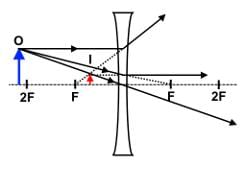
During an experiment, a thin-lens system in its initial state produces a real, inverted, and enlarged image and in its final state produces a virtual, upright, and enlarged image. Which of the following statements best elucidates on what kind of change occurred for the thin-lens system?- a)The object is moved from a point outside the radius of curvature to a point within the focal length of a concave lens.
- b)The converging lens is swapped for a diverging lens to create the switch in orientation.
- c)The object is moved from a point outside the focal length to a point within the focal length of a convex lens.
- d)An additional converging lens was placed outside the focal point of the original lens.
Correct answer is option 'C'. Can you explain this answer?
During an experiment, a thin-lens system in its initial state produces a real, inverted, and enlarged image and in its final state produces a virtual, upright, and enlarged image. Which of the following statements best elucidates on what kind of change occurred for the thin-lens system?
a)
The object is moved from a point outside the radius of curvature to a point within the focal length of a concave lens.
b)
The converging lens is swapped for a diverging lens to create the switch in orientation.
c)
The object is moved from a point outside the focal length to a point within the focal length of a convex lens.
d)
An additional converging lens was placed outside the focal point of the original lens.
|
|
Ayesha Joshi answered |
A converging lens can produce 3 different categories of images: 1) real, inverted, enlarged; 2) real, inverted, reduced; and 3) virtual, upright, enlarged.
Since the fourth image type, which is virtual, upright, and reduced, is only produced by a diverging lens. Since a virtual, upright, and enlarged image was produced in its final state, we can deduce that the lens was not switched from a converging to a diverging lens.
By adding an additional converging lens, it is assumed that the original lens is also converging. Two converging lens will produce a real and upright image since the first produces a real, inverted, and reduced image and the second will invert it again.
The image is real, inverted, and reduced when the object is beyond the radius of curvature.
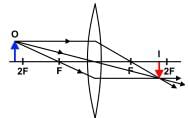

The image is real, inverted, and enlarged when the object is within the radius of curvature and beyond the focal point.
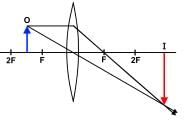
The image is virtual, upright, and enlarged when the object is within the focal point. Therefore, the correct answer is that the object is moved from a point outside the focal length to a point within the focal length for a convex or converging lens.
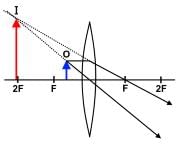
Chapter doubts & questions for Thin Lenses - Physics for MCAT 2025 is part of MCAT exam preparation. The chapters have been prepared according to the MCAT exam syllabus. The Chapter doubts & questions, notes, tests & MCQs are made for MCAT 2025 Exam. Find important definitions, questions, notes, meanings, examples, exercises, MCQs and online tests here.
Chapter doubts & questions of Thin Lenses - Physics for MCAT in English & Hindi are available as part of MCAT exam.
Download more important topics, notes, lectures and mock test series for MCAT Exam by signing up for free.
Physics for MCAT
158 videos|21 docs|21 tests
|

Contact Support
Our team is online on weekdays between 10 AM - 7 PM
Typical reply within 3 hours
|
Free Exam Preparation
at your Fingertips!
Access Free Study Material - Test Series, Structured Courses, Free Videos & Study Notes and Prepare for Your Exam With Ease

 Join the 10M+ students on EduRev
Join the 10M+ students on EduRev
|

|
Create your account for free
OR
Forgot Password
OR
Signup to see your scores
go up
within 7 days!
within 7 days!
Takes less than 10 seconds to signup









